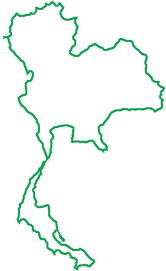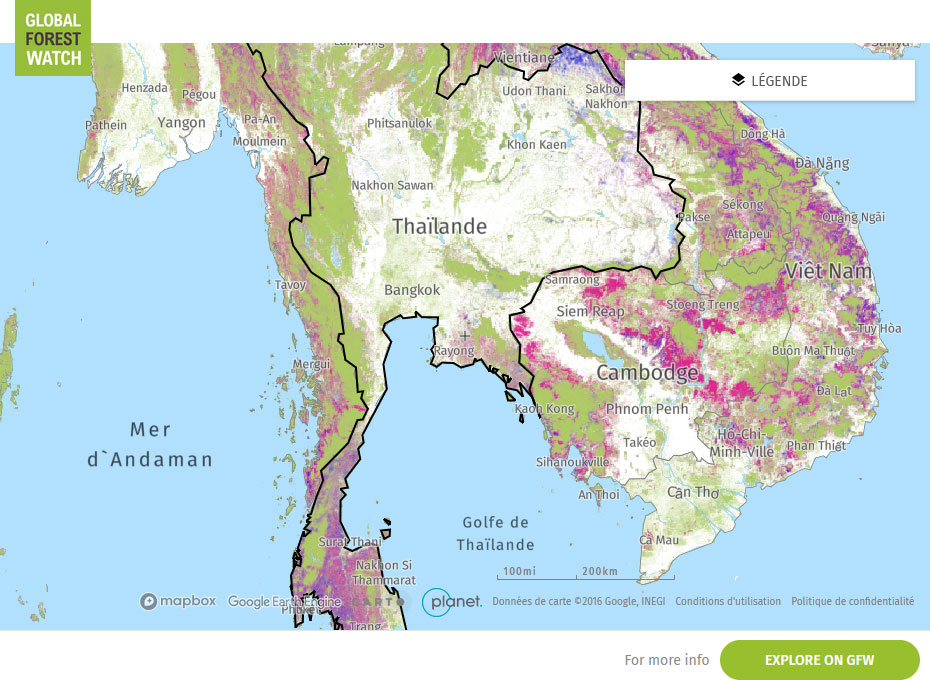Forest resources and context of Thailand
Thailand covers approximately 4.28 million hectares of forestry plantations and 1.04 million hectares of mixed-use forest, in addition to the 16.40 million hectares of conservation forest.

Land surface
51.1million ha
Forest cover
19.9million ha
Production forest
3.5million ha
Forest ownership
81.6% publicly
Forest resources in Thailand
Types of forest
Thailand forests are divided in two main types, evergreen forest (about 60% of the total forested area, including tropical evergreen forest, coniferous forest, swamp forest and beach forest) and deciduous forest (along the dry belt of the country).
Thailand covers approximately 4.28 million hectares of forestry plantations and 1.04 million hectares of mixed-use forest, in addition to the 16.40 million hectares of conservation forest. In 1989, the Government cancelled all concessions for forest lands and promoted plantation forests to develop the economy and meet the increasing demanded for timber. Between 2014-2019, reforestation was carried out by the Royal Forest Department (RFD) and forest cover was approximately stable at 31%. Currently, Thailand does not generate timber from its natural forest sources. There are still significant volumes of wood from domestic sources.
The Royal Forest Department oversees permission related to timber harvesting from forest plantations, transporting, processing and trading. It manages National Forest Reserves and Permanent Forest Estates. The Department of National Parks, Wildlife and Plant Conservation oversees approvals related to protected areas and protected species, including import/export of CITES species. The Department of Marine and Coastal Resources manages mangroves. All three of these government departments are under the Ministry of Natural Resources and Environment. The Forest Industry Organization is a state enterprise under the Royal Forest Department and received permission from them to manage forest plantations which are established in reserved forest land.
Forest ownership in Thailand
Forest plantations are on both public and private land for which the ownership is granted. Ownership of public land for forest plantations can be granted by:
- Royal Forest Department under National Reserved Forest Act B.E. 2507 (1964) and Forest Act B.E. 2484 (1941)
- The Cooperative Promotion Department and Department of Social Development and Welfare under Allotment of Land for Living Act, B.E. 2511 (1968)
- The Agricultural land Reform Office under Agricultural land Reform Act, B.E. 2518 (1975)
- Ministry of Finance under The Ratchaphatsadu Land Act, B.E. 2562 (2019)
Ownership of private land is only granted by the Department of Lands under the Land Code, B.E.2497 (1954).
As of 2017, the forest area for economic development in Thailand accounts for about 8%, with economic plantations making up 1.5%, while rubberwood forests comprise another 6.8%. Thailand aims to increase the forest area available for economic development by up to 15% before 2036. This will be achieved by promoting the establishment of plantations in appropriate areas, including public lands that are allowed to be used for this purpose.
The most common commercial species from private commercial plantation in Thailand include teak (Tectona grandis), rubber (Hevea brasiliensis), and Eucalyptus (Eucalyptus sp.) Eucalyptus, Rubberwood, and Acacia harvested in Thailand comes exclusively from plantation forest.
Between 1992 and 2015, plantations growing restricted species were allowed to register under the Forest Plantation Act B.E. 2535 (1992). In 2015, the Forest Plantation Act was amended to allow plantations growing 58 timber species specified in the Annex to register under the Forest Plantation Act (No. 2) B.E. 2558 (2015). Plantation estates can be on private or public land, including land in National Forest Reserve for which an official land documentation is required to prove occupancy, leasehold, concession, or use rights. Licensed operators can be individuals, businesses (such as cooperatives or limited companies), state agencies, or state-owned enterprises (such as the Forest Industry Organization).
key figures
| Land surface | 51.1 million hectares |
|---|---|
| Forest cover | 19.9 million hectares (38.9%); mostly naturally regenerated forest and planted forest (3.5 million hectares planted); |
| Production forest | 3.5 million hectares designated for production |
| Forest ownership | 81.6% publicly owned 18.4% privately owned |
| Annual change rate | -0.1 % per year; over the past 10 years (2010-2020) |
Source: FAO, 2015
See also: Global Forest Ressources Assessment 2020, FAO



